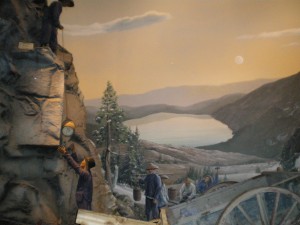Historical Archaeology and the Importance of Material Things
Historical Archaeology and the Importance of Material Things,…
 This post was prepared by Rebecca Allen, SHA Associate Editor,
This post was prepared by Rebecca Allen, SHA Associate Editor,
ESA Cultural Resources Director
The first issue of Historical Archaeology, 2015, Vol. 49, No. 1, will soon hit your mailboxes, if it is not already in your hands. Dr. Barbara Voss (Stanford University) is the thematic issue’s guest editor for ‘The Archaeology of Chinese Railroad Workers in North America.’ This issue was born out of the Chinese Railroad Workers in North America Project at Stanford University. It is part of an effort to recognize the workers’ contributions in celebration of the sesquicentennial of the first transcontinental railroad, constructed from 1865 to 1869, that stretched from California to Iowa across some of the country’s most challenging terrain. To put this topic in perspective, I invite you to view a series of videos on the subject.
 Display at Sacramento Railroad Museum, workers at Donner Summit (photo by R. Allen)
Display at Sacramento Railroad Museum, workers at Donner Summit (photo by R. Allen)
Dr. Gordon Chang (Professor of History, Stanford University) talks about his research, his perspective as an Asian American, and the creation of the Chinese Railroad Workers in North America Project. Dr. Chang states that the railroad workers are underrepresented in the documentary record. Although they appear in railroad payroll records, and are occasionally noted in newspaper accounts, no extant first-hand accounts from Chinese railroad workers have been found. Working with Drs. Chang and Shelley Fisher Fisken, Barb Voss helped to organize the Archaeology Network that stems from this initiative. Dr. Voss gathered together a roster of archaeologists who have worked on these or similar labor camps, and challenged archaeologists to offer a fuller picture of the Chinese railroad worker experience.
Chinese Railroad Workers Project Introduction Video from Chinese Railroad Workers on Vimeo.
The Chinese Railroad Workers in North America Project goals are further discussed in this introductory video featuring co-directors Gordon Chang and Shelley Fisher Fishkin. While focused on the history and archaeology of 19th century railroad workers, the Project touches on important themes in the present-day globalized economy. As Fishkin notes, “China and the U.S. have been intertwined for over 150 years. Right now, especially when a lot of goods are being created through work on both sides of the Pacific, and migrant labor is a factor in shaping the products that we use both in China and the U.S., understanding how this first massive force of migrant laborers shaped both of our countries…holds lessons which are relevant to us today.
The Society for Historical Archaeology established the Overseas Chinese Research Group at their annual meeting in 1969, and published the first thematic issue devoted to Overseas Chinese archaeology in 2008 (HA, Vol. 42, No. 3, find it on our Publications Explorer). Researchers have learned and continue to learn the importance of working with the migrants’ descendants, regional and national heritage groups, and engaging historical and historian’s perspectives. This integration of approaches expands and explores the study of marginalized populations. The contribution of Chinese railroad workers is starting to be recognized – they were recently inducted into the U.S. Department of Labor Hall of Fame – as seen in the above video.
Historical archaeology has the unique opportunity to bring dimension and depth to the railroad workers’ history, to explore topics of daily life and economic networks, and to create studies that trace workers’ experiences as they encountered and adapted to new environments and landscapes. Historical archaeology adds depth and nuance to topics of labor, economic, and social histories of the American West, made possible by the completion of this first transcontinental railroad in 1869.
Historical Archaeology, 2015, Vol. 49, No. 1 represents the contribution of more than two dozen authors and researchers. It highlights several archaeological sites directly related to the transcontinental railroad (Donner Summit, California and Promontory Summit, Utah, as well as the contribution of workers after the first transcontinental railroad was completed, with articles on Virginia & Truckee Railroad camps and Mono Mills in California, Carlin, Nevada, and Montana. Topics of bioarchaeology, health practices, habitation, zooarchaeology, and the materiality of everyday life expand the view of workers’ experience. The volume ends with commentary and a call to embrace the new direction of multidisciplinary approach and multi-ethnic considerations. I encourage you to pick up this thematic issue, and read it soon.
Gordon H. Chang and Shelley Fisher Fishkin, Fragments of the Past: Archaeology, History, and the Chinese Railroad Workers of North America
Barbara L. Voss, The Historical Experience of Labor: Archaeological Contributions to Interdisciplinary Research on Chinese Railroad Workers
Paul G. Chace, Introductory Note to Chace and Evans’ 1969 Presentation, and reprint of 1969 SHA presentation, Celestial Sojourners in the High Sierras: The Ethno-Archaeology of Chinese Railroad Workers (1865−1868)
R. Scott Baxter and Rebecca Allen, The View from Summit Camp
John Molenda, Moral Discourse and Personhood in Overseas Chinese Contexts
Michael R. Polk, Interpreting Chinese Worker Camps on the Transcontinental Railroad at Promontory Summit, Utah
Lynn Furnis and Mary L. Maniery, An Archaeological Strategy for Chinese Workers’ Camps in the West: Method and Case Study
Charlotte K. Sunseri, Alliance Strategies in the Racialized Railroad Economies of the American West
Timothy Urbaniak and Kelly J. Dixon, Inscribed in Stone: Historic Inscriptions and the Cultural Heritage of Railroad Workers
Marjorie Akin, James C. Bard, and Gary J. Weisz, Asian Coins Recovered from Chinese Railroad Labor Camps: Evidence of Cultural Practices and Transnational Exchange
J. Ryan Kennedy, Zooarchaeology, Localization, and Chinese Railroad Workers in North America
Sarah Christine Heffner, Exploring Health Care Practices of Chinese Railroad Workers in North America
Ryan P. Harrod and John J. Crandall, Rails Built of the Ancestors’ Bones: The Bioarchaeology of the Overseas Chinese Experience
Mary Praetzellis and Adrian Praetzellis, Commentary on the Archaeology of Chinese Railroad Workers in North America: Where Do We Go from Here?
Sue Fawn Chung, Forgotten Chinese Railroad Workers Remembered: Closing Commentary by a Historian